
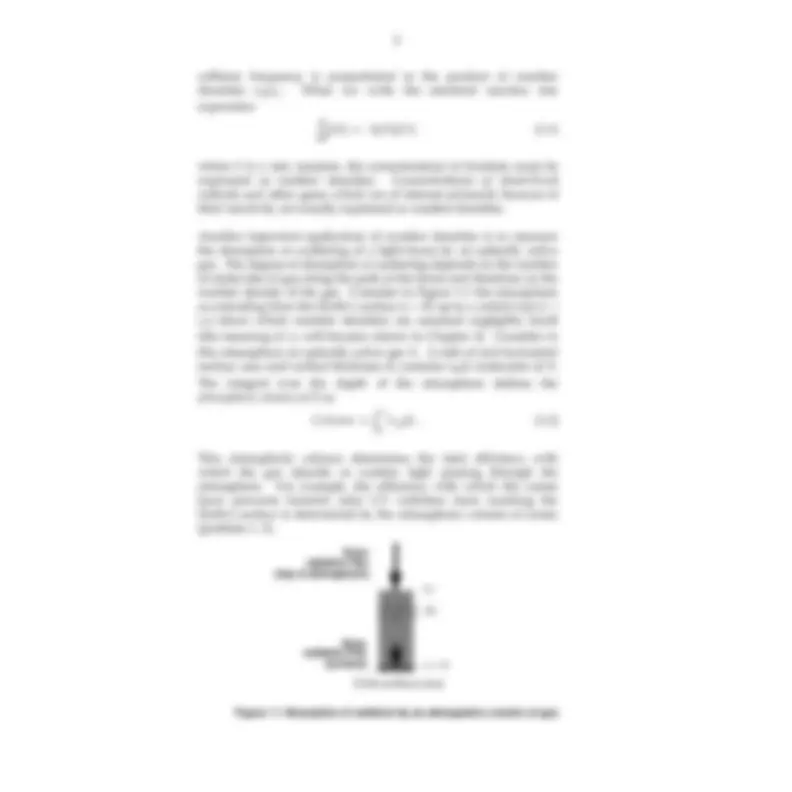
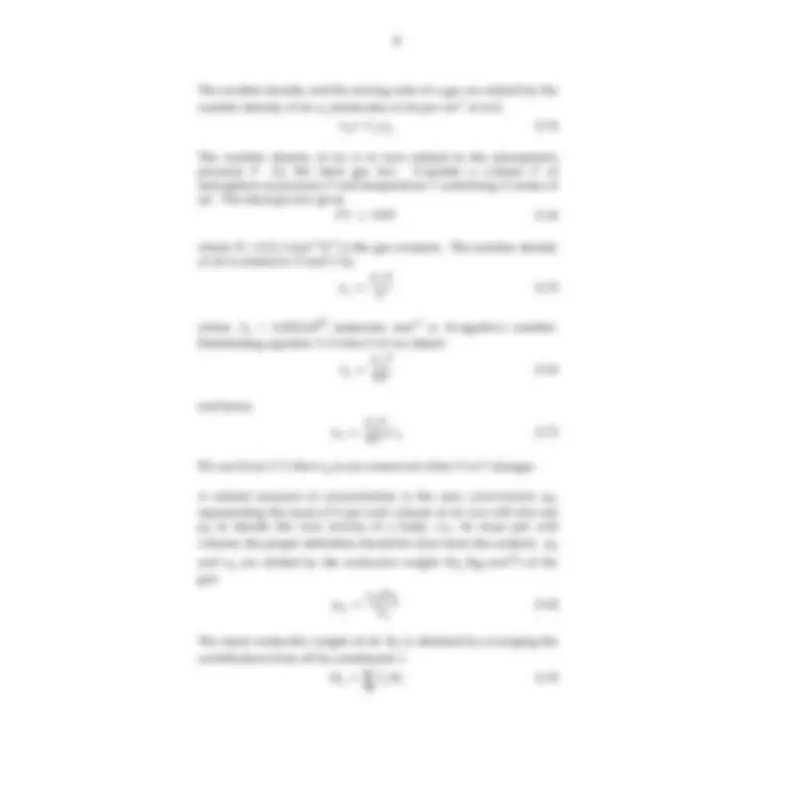
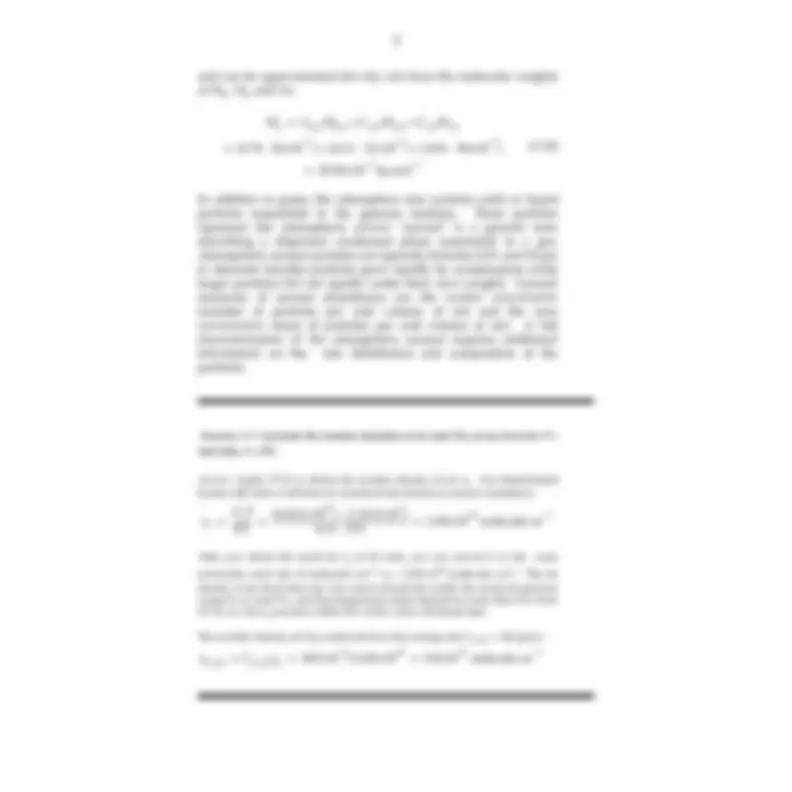
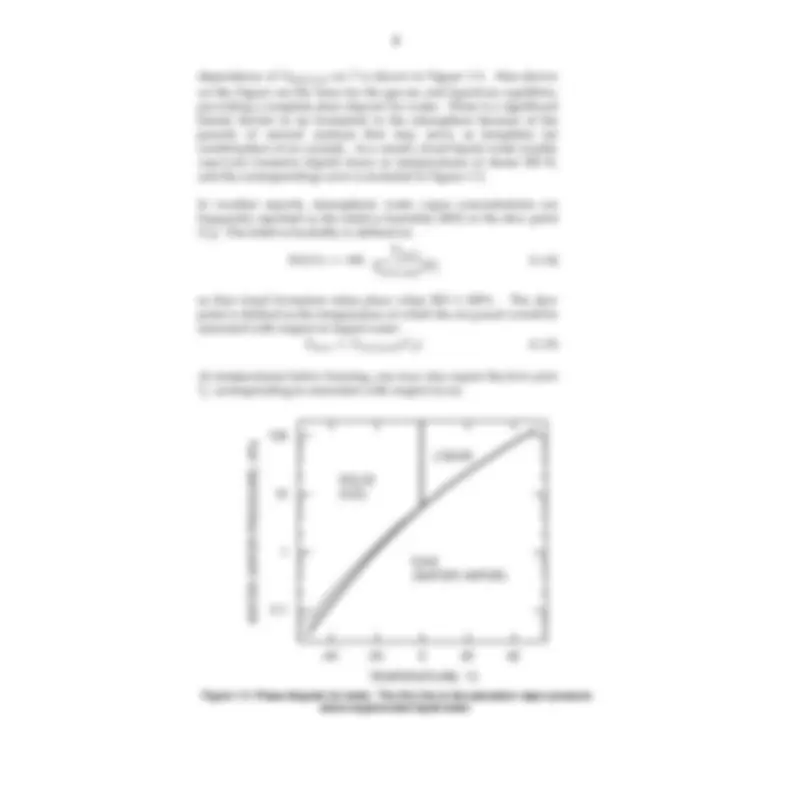
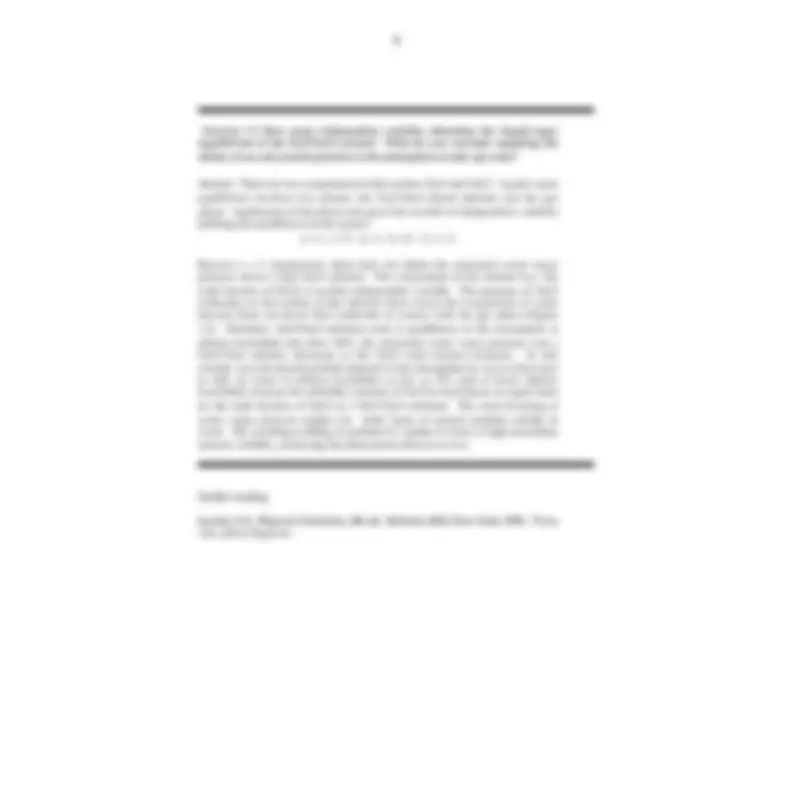


Study with the several resources on Docsity

Earn points by helping other students or get them with a premium plan


Prepare for your exams
Study with the several resources on Docsity

Earn points to download
Earn points by helping other students or get them with a premium plan
Community
Ask the community for help and clear up your study doubts
Discover the best universities in your country according to Docsity users
Free resources
Download our free guides on studying techniques, anxiety management strategies, and thesis advice from Docsity tutors
The objective of atmospheric chemistry is to understand the factors that control the concentrations of chemical species in the atmosphere. In this book we will use three principal measures of atmospheric composition: mixing ratio, number density, and partial pressure. As we will see, each measure has its own applications.
Typology: Lecture notes
1 / 9

This page cannot be seen from the preview
Don't miss anything!






The objective of atmospheric chemistry is to understand the factors that control the concentrations of chemical species in the atmosphere. In this book we will use three principal measures of atmospheric composition: mixing ratio , number density , and partial pressure. As we will see, each measure has its own applications.
The mixing ratio C (^) X of a gas X (equivalently called the mole fraction)
is defined as the number of moles of X per mole of air. It is given in units of mol/mol (abbreviation for moles per mole), or equivalently in units of v/v (volume of gas per volume of air) since the volume occupied by an ideal gas is proportional to the number of molecules. Pressures in the atmosphere are sufficiently low that the ideal gas law is always obeyed to within 1%.
The mixing ratio of a gas has the virtue of remaining constant when the air density changes (as happens when the temperature or the pressure changes). Consider a balloon filled with room air and allowed to rise in the atmosphere. As the balloon rises it expands, so that the number of molecules per unit volume inside the balloon decreases; however, the mixing ratios of the different gases in the balloon remain constant. The mixing ratio is therefore a robust measure of atmospheric composition.
Table 1-1 lists the mixing ratios of some major atmospheric gases. The most abundant is molecular nitrogen (N 2 ) with a mixing ratio
CN2 = 0.78 mol/mol; N 2 accounts for 78% of all molecules in the
atmosphere. Next in abundance are molecular oxygen (O 2 ) with
CO2 = 0.21 mol/mol, and argon (Ar) with C (^) Ar = 0.0093 mol/mol.
The mixing ratios in Table 1-1 are for dry air, excluding water vapor. Water vapor mixing ratios in the atmosphere are highly
variable (10 -6-10 -2^ mol/mol). This variability in water vapor is part of our everyday experience as it affects the ability of sweat to evaporate and the drying rate of clothes on a line.
Gases other than N 2 , O 2 , Ar, and H 2 O are present in the
atmosphere at extremely low concentrations and are called trace gases. Despite their low concentrations, these trace gases can be of critical importance for the greenhouse effect, the ozone layer, smog,
and other environmental issues. Mixing ratios of trace gases are commonly given in units of parts per million volume (ppmv or simply ppm), parts per billion volume (ppbv or ppb), or parts per trillion volume
(pptv or ppt); 1 ppmv = 1x10-6^ mol/mol, 1 ppbv = 1x10-9^ mol/mol,
and 1 pptv = 1x10 -12^ mol/mol. For example, the present-day CO 2
concentration is 365 ppmv (365x10-6^ mol/mol).
The number density n (^) X of a gas X is defined as the number of
molecules of X per unit volume of air. It is expressed commonly in
units of molecules cm-3^ (number of molecules of X per cm 3 of air). Number densities are critical for calculating gas-phase reaction rates. Consider the bimolecular gas-phase reaction
(R1)
The loss rate of X by this reaction is equal to the frequency of collisions between molecules of X and Y multiplied by the probability that a collision will result in chemical reaction. The
Table 1-1 Mixing ratios of gases in dry air
Gas Mixing ratio (mol/mol)
Nitrogen (N 2 ) 0.
Oxygen (O 2 ) 0.
Argon (Ar) 0.
Carbon dioxide (CO 2 ) (^) 365x10 -
Neon (Ne) (^) 18x10-
Ozone (O 3 ) (^) 0.01-10x10 -
Helium (He) (^) 5.2x10-
Methane (CH 4 ) (^) 1.7x10 -
Krypton (Kr) (^) 1.1x10-
Hydrogen (H 2 ) (^) 500x10-
Nitrous oxide (N 2 O) (^) 320x10-
The number density and the mixing ratio of a gas are related by the
number density of air na (molecules of air per cm^3 of air):
(1.3)
The number density of air is in turn related to the atmospheric pressure P by the ideal gas law. Consider a volume V of atmosphere at pressure P and temperature T containing N moles of air. The ideal gas law gives
(1.4)
where R = 8.31 J mol -1^ K -1^ is the gas constant. The number density of air is related to N and V by
(1.5)
where Av = 6.023x10^23 molecules mol-1^ is Avogadro’s number.
Substituting equation (1.5) into (1.4) we obtain:
(1.6)
and hence
(1.7)
We see from (1.7) that nX is not conserved when P or T changes.
A related measure of concentration is the mass concentration ρX,
representing the mass of X per unit volume of air (we will also use ρX to denote the mass density of a body, i.e., its mass per unit
volume; the proper definition should be clear from the context). ρX
and n X are related by the molecular weight M (^) X (kg mol -1^ ) of the
gas:
(1.8)
The mean molecular weight of air M (^) a is obtained by averaging the
contributions from all its constituents i :
(1.9)
n (^) X = C (^) X n (^) a
n (^) a
A (^) v N V
n (^) a
A (^) v P RT
n (^) X
A (^) v P RT
ρ X
n (^) X M (^) X A (^) v
M (^) a C (^) i M (^) i i
and can be approximated (for dry air) from the molecular weights of N2, O 2 , and Ar:
In addition to gases, the atmosphere also contains solid or liquid particles suspended in the gaseous medium. These particles represent the atmospheric aerosol ; "aerosol" is a general term describing a dispersed condensed phase suspended in a gas. Atmospheric aerosol particles are typically between 0.01 and 10 μm in diameter (smaller particles grow rapidly by condensation while larger particles fall out rapidly under their own weight). General measures of aerosol abundances are the number concentration (number of particles per unit volume of air) and the mass concentration (mass of particles per unit volume of air). A full characterization of the atmospheric aerosol requires additional information on the size distribution and composition of the particles.
Exercise 1-1 Calculate the number densities of air and CO 2 at sea level for P =
1013 hPa, T = 0o^ C.
Answer : Apply (1.6) to obtain the number density of air na. Use International System (SI) units at all times in numerical calculations to ensure consistency:
After you obtain the result for n (^) a in SI units, you can convert it to the more
commonly used unit of molecules cm -3: na = 2.69x10^19 molecules cm-3. The air density at sea level does not vary much around the world; the sea-level pressure varies by at most 5%, and the temperature rarely departs by more than 15% from 273 K, so that na remains within 25% of the value calculated here.
The number density of CO2 is derived from the mixing ratio CCO2 = 365 ppmv:
M (^) a = C (^) N 2 M (^) N 2 + C (^) O 2 M (^) O 2 + C (^) Ar M (^) Ar
0.78 28x
28.96x
n (^) a
A (^) v P RT
6.023x 23 ( ) 1.013x 5 ⋅ ( ) 8.31 ⋅ 273
------------------------------------------------------------------- 2.69x 25 molecules m
n (^) CO 2 C (^) CO 2 n (^) a 365x
Figure 1-2 Evaporation of water from a pan
The H 2 O molecules in the liquid are in constant motion. As a result
of this motion, H 2 O molecules at the surface of the pan evaporate to
the atmosphere. If we let this evaporation take place for a long enough time, the pan will dry out. Let us place a lid on top of the pan to prevent the H 2 O molecules from escaping (Figure 1-2b). The
H 2 O molecules escaping from the pan bounce on the lid and must
now eventually return to the pan; a steady state is achieved when the rate at which molecules evaporate from the pan equals the rate at which water vapor molecules return to the pan by collision with the liquid water surface. The collision rate is determined by the water vapor pressure PH2O in the head space. Equilibrium
between the liquid phase and the gas phase is achieved when a saturation vapor pressure PH2O , SAT is reached in the head space. If
we increase the temperature of the water in the pan, the energy of the molecules at the surface increases and hence the rate of evaporation increases. A higher collision rate of water vapor molecules with the surface is then needed to maintain equilibrium. Therefore, PH2O,SAT increases as the temperature increases.
Cloud formation in the atmosphere takes place when P (^) H2O ≥
PH2O,SAT , and it is therefore important to understand how PH2O,SAT
depends on environmental variables. From the phase rule, the number n of independent variables determining the equilibrium of c chemical components between a number p of different phases is given by
(1.13)
In the case of the equilibrium of liquid water with its vapor there is only one component and two phases. Thus the equilibrium is determined by one single independent variable; at a given temperature T, there is only one saturation vapor pressure PH2O,SAT ( T) for which liquid and gas are in equilibrium. The
n = c + 2 – p
dependence of PH2O,SAT on T is shown in Figure 1-3. Also shown
on the Figure are the lines for the gas-ice and liquid-ice equilibria, providing a complete phase diagram for water. There is a significant kinetic barrier to ice formation in the atmosphere because of the paucity of aerosol surfaces that may serve as templates for condensation of ice crystals. As a result, cloud liquid water readily supercools (remains liquid) down to temperatures of about 250 K, and the corresponding curve is included in Figure 1-3.
In weather reports, atmospheric water vapor concentrations are frequently reported as the relative humidity (RH) or the dew point ( Td ). The relative humidity is defined as:
(1.14)
so that cloud formation takes place when RH ≥ 100%. The dew point is defined as the temperature at which the air parcel would be saturated with respect to liquid water:
(1.15)
At temperatures below freezing, one may also report the frost point Tf corresponding to saturation with respect to ice.
Figure 1-3 Phase diagram for water. The thin line is the saturation vapor pressure above supercooled liquid water.
P (^) H 2 O = P (^) H 2 O ,SAT ( T (^) d )
WATER VAPOR PRESSURE, hPa